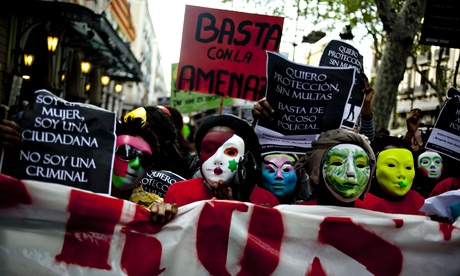
Officials from Spain's National Statistics Institute (INE) have been calling on the national brothel-keepers' organisation in an effort to assess the contribution that prostitution makes to GDP.
The almost impossible task of calculating the money generated by the oldest profession is being undertaken to conform with a European edict demanding that member states declare the percentage of GDP derived from illegal activities such as the sex trade, drug and people trafficking and contraband. Countries have until 2016 to comply.
Adding up the contributions made by illegal activities could have benefits – increasing GDP has the effect of reducing the public deficit as a ratio of output, so sex workers and drug dealers may help member states to drop below the EU debt ceiling of 3% of output.
José Roca, a spokesman for Anela, the association of clubs de alterne (alternate clubs), as brothels are euphemistically known in Spain, told El País newspaper that he thought it was a prank when the INE phoned asking for financial data.
The statisticians wanted to know how many prostitutes were needed for a club to be viable. The answer, according to Roca, is 50. They also wanted to know the average charge per service (€40-€70) and how many clients each sex worker saw each day (four to eight).
The Office for National Statistics estimated last month that the contribution made to national output by sex workers and the illegal drug trade in the UK was £9.7bn, or 0.7% of GDP, in 2009, the latest year for which estimates are available. Sex work generated £5.3bn for the economy that year, with the remaining £4.4bn coming from cannabis, heroin, cocaine, crack, ecstasy and amphetamines.
According to Eurostat, illegal activities such as prostitution and drug trafficking, together with accounting changes covering rather less gritty subjects such as pensions – could add about 1% to the GDP of Poland and Romania, 1%-2% to Spain and Italy, 3%-4% to the UK and as much as 5% to the GDP of Finland and Sweden.
Inevitably, there are few reliable statistics. Most estimates put the number of sex workers in Spain at 300,000 – five times as many as are estimated to work in the UK – and, in a 2009 government survey, 39% of Spanish men said they had paid for sex.
A police source estimated that, with an average of five clients a day paying about €40 a service, that it worked out at €60m a day. Assuming that the sex workers don't work seven days a week and perhaps only half are working at any one time, it could still add up to about €10bn a year.
"In reality it's impossible to calculate," Roca told the paper. "There is no census of prostitutes, nor clubs, nor the number or cost of services. You might as well pick a number."
Spain has long been Europe's port of entry for cocaine from Latin America and hashish from Morocco. Last year the police confiscated 21 tonnes of cocaine, 325 tonnes of hashish and 229 kilos of heroin. As a rule of thumb, police estimate that confiscated drugs represent 10%-15% of the total in circulation.
According to Spain's interior ministry, drug dealing generates close to €16m a day, or €5.7bn a year. Spain's GDP in the first quarter of this year was around €256bn, so the drug trade could account for about 0.5% of GDP, and prostitution 1%.
Estimated increases
Estimated increase in GDP due to new European Union accounting methods, which will include contributions to output generated by drugs, prostitution and other activities from 2016:
0%-1% Hungary, Latvia, Lithuania, Poland, Romania
1%-2% Czech Republic, Estonia, Ireland, Italy, Malta, Portugal, Slovakia, Slovenia, Spain
2%-3% Belgium, Denmark, Germany, France
3%-4% Austria, Netherlands, UK
4%-5% Finland, Sweden
Source: Eurostat

